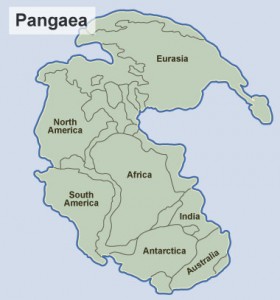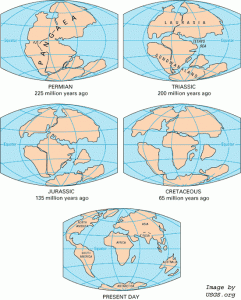The Continents
GAIA lives and changes in its appearance, like all living beings over the course of their existence, through the interaction in the divine universe and through inner maturity.
Continental drift
We can observe this exterior change in the earth with the continents, which, driven by the geodynamo in the earth’s core (see page 62) and the light of the sun, is constantly in motion. Dr. Udo Neumann expresses the situation succinctly:
“Since early in its history two global motors have dominated the earth:
– the interior motor driven by the heat source within the earth,
– the exterior motor fed by solar energy radiating upon its surface
The cooling core of the earth (approx. 4,500°C) provides enough crystallization heat to warm up the mantle above. This allows for mantle convection, which represents the motor responsible for movement of the plates in the earth’s crust and the formation of mountain ranges (basic principle of plate tectonics). The exterior heat is mainly responsible for our climate and weather. Related processes cause the erosion of mountain ranges and rock formations on the earth’s surface and create the great variety of landscapes.”
(Neumann – III.13)
Pangaea (250 million years BC)
Tracing the continental drift back 250 million years ago, we reach the Permian period, in which all of today’s continents were connected. That means that there was only a single land mass, the so-called supercontinent of Pangaea. Because of its shape, it is also called the “embryo of the earth”. The rest of the globe was covered with water, the giant ocean of Panthalassa.
Gondwana and Laurasia (200 million years BC)
It is assumed that this land mass split into two giant continents, Gondwana and Laurasia, about 200 million years ago, in the Triassic period.
Eurasia and North America (135 million years BC)
About 135 million years ago – in the Jurassic period – the northern continental mass of Laurasia broke apart, creating the two new continents of North America and Eurasia by opening the North Atlantic.
Emergence of today’s continents
Over the course of 70 million years, until around 65 million years BC – in the Cretaceous period – the process of continental separation continued and the large southern continent broke apart to form South America, Africa, India, Australia and Antarctica.
Continents around 30,000 BC
Thereafter, the continents simply drifted slowly apart until, in recent geological history, a rift appeared. Around 32,000 years ago, the Pacific plate lowered, causing the island kingdom of Lemuria to sink below sea level and with it the first advanced civilization on earth, which we will see again at the main power places: the Lemurians.
Continents around 10,000 BC
About 12,000 years ago, another exceptional rift appeared. The Atlantic plate between Europe and North America dropped suddenly, raising other continents such as South America. This event will be discussed in detail in the descriptions of the 14 main power places. The flood waves that, in the most literal sense, went around the world are reflected in the legends of great floods that nearly all scriptures and religions record. It also meant the destruction of an advanced civilization, the legendary continent of Atlantis. The descendants of the Atlanteans left us majestic megalithic structures which we will examine more closely when we turn to the power places.
The continents today
Since that time, the continents have only moved a few kilometers, but a new movement is beginning (see page 656).
Drift into the future (20 million years AD)
Geological research indicates that the continental plates are becoming more dynamic and drift is increasing. In about 20 million years, east Africa will split off from the rest of Africa along the East African Rift, creating a new ocean. The Black Sea will be cut off completely from the Mediterranean and the Gulf of Aqaba will reach Turkey. The Iberian Peninsula, containing Spain and Portugal, will detach itself from Europe, turning clockwise as it does so. Australia and New Zealand will drift north; northern Australia will lie on the equator.
Note:
Continental drift also explains why a few of the lines and places to be described no longer correspond exactly to the original grid.
This is just a small excerpt from the book GAIA LEGACY.


